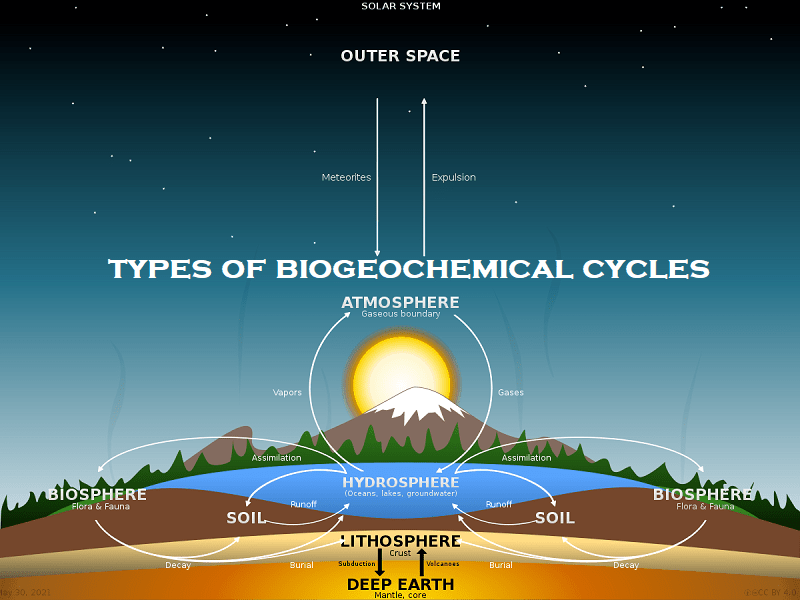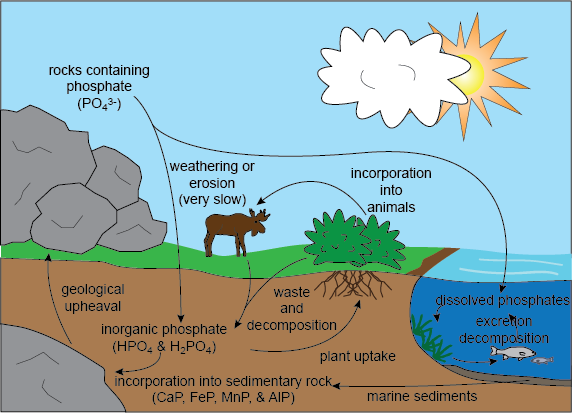Which Biogeochemical Cycle Does Not Involve the Atmosphere
The biochemical cycle is also called a biogeochemical cycle or nutrient cycle. However it gradually depletes in soil.

Basic 6 Types Of Biogeochemical Cycles With Examples
The atmosphere hydrosphere and lithosphere are the abiotic components of the ecosystem.

. Types of Biogeochemical Cycles. In the nitrogen cycle bacteria that live in soil and on plant roots in a symbiotic relationship with legumes change nitrogen gas into ammonia in a process called nitrogen fixation Which biogeochemical cycle does NOT involve a stage where the chemical enters the atmosphere. Examples of these are phosphorus P calcium Ca and silica Si cycles.
The overgrowth of naturally occurring. The phosphorus cycle does not involve the atmosphere because it is usually in a liquid state at a room temperature. Which one is many gaseous cycle.
Phosphorus mainly passes through the hydrosphere lithosphere and biosphere. Water with a longer residence time such as water in oceans and glaciers is not available for short-term cycling which occurs via evaporation. The overgrowth of naturally occurring microbial communities is typically limited by the availability of nitrogen as previously mentioned phosphorus and iron.
Which biogeochemical cycle does not involve a stage where the chemical enters the atmosphere. When an ecosystem is limited by a single nutrient that either is scarce or cycles very slowly this substance is called a an _____ limiting nutrient. The phosphorus cycle Which biogeochemical cycle does not involve a stage where a chemical enters the.
Explain how human activities have impacted these cycles and the resulting potential consequences for Earth. Discuss the biogeochemical cycles of water carbon nitrogen phosphorus and sulfur. Low concentration of phosphorus in soils reduces plant growth and slows soil microbial growth as.
Not recycled in a biogeochemical cycle in the biosphere. Gaseous cycles Includes Carbon Oxygen Nitrogen and the Water cycle. By the end of this section you will be able to.
These biogeochemical cycles do not involve redox chemistry but instead involve fluctuations in the solubility of compounds containing calcium phosphorous and silica. These biogeochemical cycles do not involve redox chemistry but instead involve fluctuations in the solubility of compounds containing calcium phosphorous and silica. Sedimentary cycles Includes Sulphur Phosphorus Rock cycle etc.
Plants and phytoplankton cannot incorporate nitrogen from the atmosphere where it exists as tightly bonded triple covalent N 2. Which biogeochemical cycle does NOT involve a stage where the chemical enters the atmosphere. The cycling of these elements is particularly important in oceans because large quantities of these elements are incorporated into the exoskeletons of marine organisms.
The phosphorus cycle does not have an atmospheric componentThe phosphorus cyclephosphorus cycleThe phosphorus cycle is the biogeochemical cycle that describes the movement of phosphorus through the lithosphere hydrosphere and biosphere. The cycling of these elements is particularly important in oceans because large quantities of these elements are incorporated into the exoskeletons of marine organisms. Phosphorus cycle is said to be a very slow process.
Which biogeochemical cycle does NOT involve a stage where the chemical enters the atmosphere. Change nitrogen gas into ammonia by a process called nitrogen fixation which allows other bacteria to convert the ammonia to nitrates and nitrites What biogeochemical cycle does NOT involve a stage where the chemical enters the atmosphere. Surface water evaporates water to water vapor or sublimates ice to water vapor which deposits.
Calcium cycle sodium cycle phosphorus cycle iron cycle magnesium cycle sulphur cycle are. What biogeochemical cycle does NOT involve a stage where the chemical enters the atmosphere. This is the reason why it cycles only through water sediments or soil.
Biology Change in Communities Biogeochemical Cycles 1 Answer Meave60 Feb 4 2017 The phosphorus cycle does not have an atmospheric component. Several other elements undergo chemical cycles that do not involve redox chemistry. The overgrowth of naturally occurring microbial communities is typically limited by the availability of nitrogen as previously mentioned phosphorus and iron.
Biogeochemical cycles Bacteria that live on the roots of plants. Nitrogen carbon and oxygen are found in the gaseous form in the atmosphere. The biochemical cycle with the gaseous phase includes various cycles like the carbon cycle nitrogen cycle oxygen cycle.
It is essential for both animal and plant growth. Biogeochemical cycles are basically divided into two types. Which major biogeochemical cycle does not have an atmospheric component.
In comparison to the carbon cycle the phosphorus cycle does not pass through the atmosphere. Examples of these are phosphorus P calcium Ca and silica Si cycles. These biogeochemical cycles do not involve redox chemistry but instead involve fluctuations in the solubility of compounds containing calcium phosphorous and silica.
Carbon cycles through all but this and water enters atmosphere through leaves of plants. Which biogeochemical cycle does not include a major path in which the substance cycles. Energy flows directionally through ecosystems entering as sunlight or.
Several other elements undergo chemical cycles that do not involve redox chemistry.

Image Result For Usgs Nitrogen Cycle Nitrogen Cycle Global Warming Education Kindergarten

Biogeochemical Cycles Microbiology

Which Major Biogeochemical Cycle Does Not Have An Atmospheric Component Socratic

1118 778 Texasgateway Org Sulphur Cycle Ocean Ecosystem Biology
Comments
Post a Comment